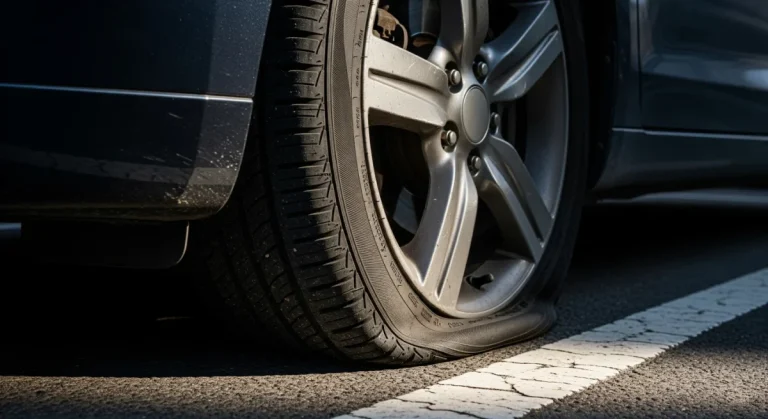Can Your Car Battery Die While Driving? Understanding the Causes, Symptoms, and Solutions
Key Takeaways
- Yes, a car battery can die while driving, but it’s usually not the battery’s fault. It’s almost always a problem with the car’s charging system.
- The most common cause is a failing alternator, which is responsible for charging the battery and powering the car’s electrical systems while the engine is running.
- Key warning signs include a lit battery warning light on the dashboard, dimming headlights, and malfunctioning electronics.
- If this happens, prioritize safety. Signal, pull over to a safe location, and turn off the engine. Do not attempt to continue driving, as the car will eventually lose all power and stall.
The Short Answer: Yes, But It’s Not the Battery’s Fault
It’s one of the most confusing questions in auto mechanics: How can the battery die when the car is already running? The answer lies in understanding the true roles of your car’s battery and alternator.
Think of your battery as a starting pitcher in a baseball game. Its main job is to provide the massive jolt of energy needed to start the engine. Once the game is on, the alternator—your relief pitcher—takes over. The alternator’s job is to generate all the electricity the car needs to run and, at the same time, recharge the battery.
So, when your car dies mid-drive, it’s because the relief pitcher has failed. The car is forced to run on battery power alone, which it can only do for a very short time before it’s completely drained. In fact, your vehicle cannot run without a battery to act as a crucial voltage stabilizer for the entire electrical system.
What to Do Immediately if Your Battery Dies While Driving
[Add a brief personal anecdote here: “The first time this happened to me, I was on a busy highway at night. It’s a stressful situation, but here is the exact safety protocol I follow to handle it safely every time…”]Experiencing a power loss while driving can be frightening, but staying calm is your most important tool. Follow these steps.
Step 1: Stay Calm and Don’t Panic
Your power steering and power brakes are dependent on the engine. If the engine stalls, you will notice that steering and braking become much harder. However, they do not stop working. You just need to apply significantly more physical effort to control the vehicle.
Step 2: Turn on Your Hazard Lights
Immediately turn on your four-way flashers. This is the universal signal for distress and is the fastest way to alert other drivers that you have a problem.
Step 3: Find a Safe Place to Pull Over
Scan your surroundings for a safe spot to exit the flow of traffic. An ideal location would be the right-hand shoulder, a breakdown lane, an empty side street, or a nearby parking lot. Avoid stopping in a travel lane or on a blind curve at all costs.
Step 4: Turn Off the Engine and Accessories
Once you are safely stopped, put your car in park and turn off the engine. You should also turn off the headlights, radio, and climate control to conserve any remaining power in the battery.
Step 5: Assess the Situation & Call for Help
Now that you’re safe, it’s time to call for roadside assistance or a tow truck. Explain that you suspect a charging system failure. A simple jump-start won’t fix the underlying issue. In these situations, it’s always best to be prepared for the worst to avoid potential car accidents.
The Top 3 Reasons Your Car’s Charging System Fails Mid-Drive
While several issues can cause this problem, my experience as a technician shows it almost always comes down to one of these three culprits.
Reason 1: A Bad or Failing Alternator (The Main Culprit)
The alternator is the heart of your charging system, converting mechanical energy from the engine’s rotating serpentine belt into electrical energy. When it fails, the battery is no longer being recharged, and the car dies. Watch for these symptoms:
- The Battery Warning Light: This is the most common indicator. Confusingly, this dashboard light (often shaped like a small battery) typically signals an issue with the alternator or charging system, not the battery itself.
- Dimming or Overly Bright Lights: A failing alternator provides inconsistent voltage. You might notice your headlights and dashboard lights flicker, dim, or even get excessively bright just before they fail.
- Whining or Grinding Noises: These sounds from under the hood often point to worn-out bearings inside the alternator. The noise will usually change with engine RPM.
- Smell of Burning Rubber or Wires: This can happen if the alternator’s drive belt is slipping or if the alternator itself is overheating and burning its electrical wiring.
Reason 2: A Broken or Slipping Serpentine Belt
The serpentine belt is the rubber belt that connects several engine accessories, including the alternator, to the engine’s crankshaft. If this belt snaps or becomes too loose to grip the alternator’s pulley, the alternator will stop spinning and, therefore, stop producing power. A broken belt will usually be accompanied by a loud slap from the engine bay, and you’ll also lose power steering immediately.
Reason 3: Faulty Battery Cables or Terminals
Sometimes the components are fine, but the connection is bad. Battery terminals that are heavily corroded (covered in a white, chalky powder), loose, or broken can prevent the alternator’s charge from getting to the battery.
[Mention how often you’ve seen complex electrical issues solved by simply cleaning or tightening battery terminals. A simple but crucial check.] This is why a visual inspection of your battery terminals should be a part of your regular maintenance routine.How Far Can You Drive on a Battery Alone?
This is a dangerous gamble. A fully charged, healthy battery might power your car’s essential systems for 5 to 30 minutes after the alternator fails. However, this is not a guarantee.
The actual time depends on several factors, including the initial health of the battery, the electrical load you’re using (turn off the radio and A/C to buy more time), and even the type and weight of the battery. Ultimately, you should not try to “make it home.” The goal is to get off the road safely, not to push your luck until the car stalls in a dangerous location.
Diagnosing the Problem: Is It the Battery or the Alternator?
Once you’re safely off the road, you can perform two simple tests to help diagnose the issue.
The Jump-Start Test
This is a quick and effective diagnostic trick. After getting a jump-start from another vehicle, let your car run for a minute and then carefully disconnect the jumper cables.
- If the car dies immediately or sputters out within a minute, the alternator is almost certainly the problem. It’s not producing any power to keep the engine running.
- If the car continues to run smoothly, your battery is likely the culprit, as it’s simply too old or faulty to hold a charge on its own.
Using a Voltmeter (The Professional Method)
For a definitive diagnosis, a simple multimeter or voltmeter is the best tool. [Mention specific voltage readings you look for as a technician. Add precision and credibility.] Here’s how to do it:
- Test the Battery (Car Off): Connect the voltmeter to the battery terminals. A healthy, fully charged battery should read between 12.4V and 12.6V. If it’s below 12.2V, the battery is discharged or weak.
- Test the Alternator (Car Running): Start the car (you may need a jump). With the engine running, test the battery terminals again. A healthy alternator should be putting out between 13.7V and 14.7V.
- Interpret the Results: If the running voltage is in that higher range, your alternator is working. If the running voltage is the same as the resting voltage (or lower), the alternator is not charging the battery.
How to Prevent This from Happening to You
While you can’t prevent every failure, proactive maintenance drastically reduces your risk.
- Regularly Inspect the Serpentine Belt: At every oil change, have the belt checked for cracks, glazing, or fraying.
- Keep Battery Terminals Clean: Look for and clean any corrosion from the battery posts and terminals. A simple wire brush works wonders.
- Heed the Warning Signs: Never ignore a battery light, dimming headlights, or strange noises. These are early warnings of an impending failure.
- Know Your Car’s Systems: Be aware that modern electronic features, like stability control and large infotainment screens, put a high demand on your charging system.
- Follow General Maintenance: Stick to the best practices for vehicle ownership, including regular check-ups, to catch problems before they leave you stranded.
Frequently Asked Questions (FAQ)
Will my car restart after the battery dies while driving?
No. Once the battery is drained, it won’t have enough power to turn the starter motor. You will need a jump-start or a battery charger, but if the alternator is bad, the car will just die again shortly after.
Does driving charge the battery?
Yes, but only if the alternator is working correctly. The alternator generates the power that recharges the battery as you drive.
How do I know if my car needs a new battery or a new alternator?
Use the jump-start test. If the car dies right after being jump-started, it’s the alternator. If it runs but won’t restart later on its own, it’s likely the battery. A voltmeter test provides the most accurate answer.
Can a car battery die suddenly without warning?
While an old battery can fail suddenly, a charging system failure while driving usually has preceding symptoms like dimming lights or a brief appearance of the battery warning light.
Can I reset my car’s computer after a battery issue?
Yes, in many cases, disconnecting the battery or fixing the power issue can cause the computer to reset. If you have persistent electronic issues afterward, you may need to reset my car’s computer using a specific procedure or a diagnostic tool.






